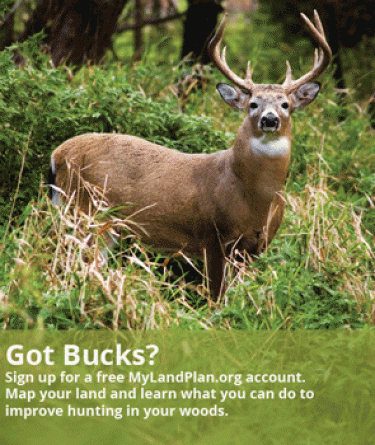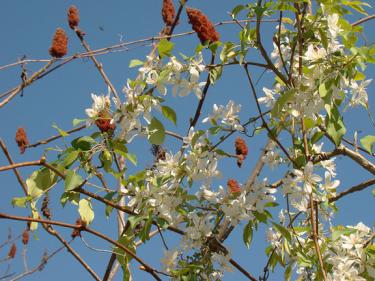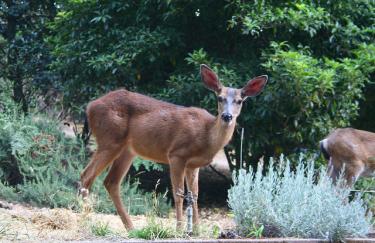How to attract whitetail to your land
When it comes to creating an ideal habitat for white-tailed deer, the three factors you have the most control over are food, cover and water. Use the strategies listed below to make your woodland a more attractive place for deer to call home.
Food
The first thing many landowners do to attract deer is to plant food pots and establish feeders. While these can be part of a successful management strategy, they are relatively expensive and intensive tools. Instead, consider managing natural vegetation to attract deer, rather than sacrificing time, money and productive acreage to food plots and feeders.
Managing natural vegetation: The following woodland management activities can help to meet the special needs of white-tailed deer:
- Discing (or strip disking): Disturbing the soil through shallow tillage (also known as “discing”) stimulates the growth of native grasses and forbs, and the resprouting of many woody species. It also helps control brush.
- Mowing: Mowing should go hand-in-hand with discing. Concentrate on edge roads, fire breaks and old fields to remove old-growth grasses and disperse seeds.
- Thinning and harvesting: Reducing tree density in the woods can greatly increase the availability of browse by allowing sunlight to reach the forest floor. It also allows the trees you leave behind to grow better. Concentrate on removing undesirable tree species to allow desirable deer browse such as blackberry, honeysuckle, poison ivy, grape and young oak species to take hold.
- Fertilizing: Adding fertilizer to thinned patches of woodland will increase the productivity of browse. You can also fertilize along the edges of tree stands, roadways and other borders where browse tends to thrive.
- Creating openings: About 10 percent of your forest acreage should consist of openings. Create them by clear-cutting one- to five-acre
patches throughout the forest.White-tailed deer like the fruit and stems of staghorn sumac.
- Prescribed burning: One of the most common tools for managing deer habitat, controlled burns diversify vegetation, stimulate the growth of desirable food plants, including browse and forbs, improves nutritional quality and palatability of plants, as well as making them more accessibility. It also helps control brush.
- Managing for mast: Removing undesirable trees, and cultivating and planting mast-producing trees can all help nourish and attract wildlife. Ideally, 20 to 30 percent of your woodland should consist of these fruit- and nut-bearing trees. Deer love acorns, especially from white oaks, beech, chestnut and hickory. Soft mast from persimmon, crabapple, honey locusts, sumacs as well as domestic apple and pear trees will also attract deer. Learn more about managing mast to attract deer and other wildlife from this article in Tree Farmer magazine. Learn more about managing native vegetation and planting trees for white-tailed deer.
- Planting food plots: Follow these tips to establish food plots as a supplement to natural forage. Food plots can also be used to concentrate deer on your property for hunting purposes.
Where: Plant food plots throughout your property. Firebreaks, small openings among planted pines, cut-overs, swamps and wooded areas are best.
What: A good rule of thumb is 60:20:20, meaning 60 percent cool-season perennials (clovers); 20 percent cool-season annuals (brassicas—rape, turnip and kale); and, 20 percent warm-season annuals (corn, soybeans, alfalfa). You can purchase seed mixes specifically designed for different kinds of deer food plots. In general, perennials are more economical and productive than annuals over time, but they require mowing, fertilization and weed control. Annuals are relatively easy to establish and tend to be more productive in the short term.
How much:Planting three to five percent of the land is enough: Research has shown that food plots on as little as one percent of the land lead
to improvements in the deer's body weight, and other measures of health.
Find out more about planting food plots.
Cover
Many of the same habitat management activities mentioned above can also be used to improve cover. For example, thinning residue (known as “slash”) can be left to create cover. Thinning will also help increase understory vegetation. Deer may use food plots containing corn, for example, for cover. And mowing can be used to reestablish native grasses.
Water
Although deer get much of their water from food, they make seek out free water in warmer seasons. So make sure they have a perennially accessible source of water, such as a river, creek, pond, watering hole or tank. And make sure to protect your waterways by maintaining a corridor of trees—a forested buffer zone—on both sides to control erosion and filter out pollutants. These trees will also provide cover for wildlife.
Find out more about attracting bucks to your property in this article from the AFF’s Tree Farmer magazine.
How can I get more tips?
It’s simple! Enter your email below.



